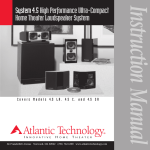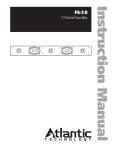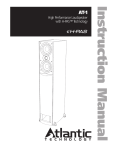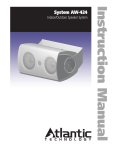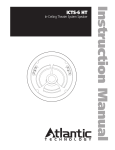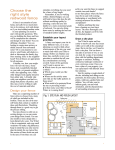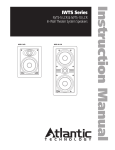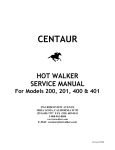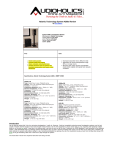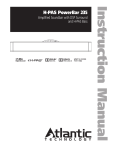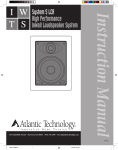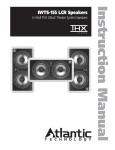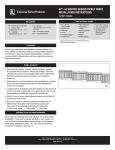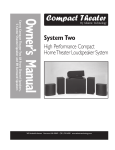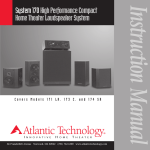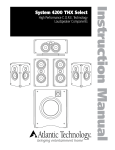Download Atlantic Technology T90 User's Manual
Transcript
Covers Models T90 LR, T90 C, and T90 SR Atlantic Technology ® I N N O V A T I V E H O M E T H E A T E R 343 Vanderbilt Avenue Norwood, MA 02062 (781) 762-6300 www.atlantictechnology.com Instruction Manual System T90 High Performance Compact Home Theater Loudspeaker System Models T90 LR, T90 C, and T90 SR SYSTEM T90 High Performance Compact Home Theater Loudspeaker System Thank you for choosing Atlantic Technology home theater products. Your new speaker system is precision crafted to give you years of enjoyable, trouble free service. This manual covers the Atlantic Technology T90 series of speakers for home theater. The T90 PBM Subwoofer is covered in detail in a separate manual. Every T90 component has been optimized for use with all surround sound formats including Dolby Surround®, Dolby Pro-Logic®, Dolby Digital 5.1®, Surround EX 6.1®, and all DTS® surround formats. T90 LR Front Channel Speaker The T90 LR Front Channel Speakers are two-way systems intended for use only with a quality subwoofer. Each speaker contains a 5.25" TCMG (Titanium Coated Molded Graphite) woofer, and a 1" Ferrofluid® cooled, Fabric Dome tweeter with a powerful neodymium magnet, in an acoustically inert MDF cabinet. The T90 LR speakers are magnetically shielded so they may be placed next to a TV set without concern. T90 C Center Channel Speaker The T90 C uses dual 5.25" TCMG woofers and the same 1" tweeter as the T90 LR speaker. The T90 C is designed for use only as a dedicated center channel speaker. The T90 C center speaker is designed to be used in a horizontal position, directly above or below the TV screen. It too is magnetically shielded and will have no adverse effects on the TV. T90 SR Surround Speaker The T90 SR TriVector™ Surround Speaker is intended to be used in multi-channel audio/video sound systems only as a dedicated surround speaker. Each enclosure has a 5.25" TCMG woofer on its front and two wide dispersion 3/4" Modified Dome tweeters, one on each side. The dual tweeters and single woofer are electronically phased to produce diffuse high frequency ambience with limited midrange localization. The T90 SR’s unique TriVector design makes it well suited for all analog and digital surround applications. IMPORTANT NOTE: The unique shape of the T90 SR lends itself to more than one mounting method. By aiming the front mounted driver directly at the prime listening position, you can create a more localizable surround field. Aiming them away produces a more diffuse surround field. Simply choose the appropriate threaded insert to attach the keyhole adapter. Connecting Your System We recommend that you connect your T90 system with high quality dual conductor stranded wire of 18 gauge or larger, for runs up to 15 feet. (Note: The lower the gauge number, the larger the wire). Use 16 gauge or larger for runs up to 30 feet and 14 gauge for runs up to 50 feet. Contact your Atlantic Technology dealer for specific cable recommendations and further information for special circumstances. ○ ○ ○ ○ ○ ○ ○ ○ ○ ○ ○ ○ ○ ○ ○ ○ ○ ○ ○ ○ ○ ○ ○ ○ ○ ○ 2 ○ ○ ○ ○ ○ ○ ○ ○ ○ ○ ○ ○ ○ ○ ○ ○ ○ ○ ○ ○ ○ ○ ○ ○ ○ ○ Atlantic Technology ® Warning: To prevent risk of electrical shock or damage to your equipment, always switch off the amplifier or receiver when making connections to the speakers. You can connect your T90 speakers by using a variety of audio connectors such as pin connectors, spade lugs, etc., or you can: 1. Remove 1/2" of insulation from each wire end. 2. Twist the stranded wire together, keeping the two conductors separate. 3. Place the appropriate conductor through the appropriate postholes in the connectors. These holes are revealed when you loosen the connector capscrew. 4. Screw down the capscrew tightly, but be careful not to over tighten. Check the tightness of the capscrews 24 hours after hookup and occasionally thereafter, as they can loosen over time. We recommend that you check your local electrical codes to make sure that you are not using an improper connector. It’s important to observe polarity while making speaker connections: red (+) terminals on the amplifier to red (+) on the speaker, black (-) on the amplifier to black (-) on the speaker. Look carefully at the wires you are using and note that one of conductors of each pair will be identified by color, printing on the outer jacket, ridges on the outer jacket, or a thread intertwined with the wire strands. By convention, the marked wire is connected to the red (+) terminal. Figure 1: Gold plated 5-way binding posts. Accepts up to 10 gauge bare wire When you’re done hooking up your T90 system the wiring should look like the diagram in Figure 2. WARNING: Before turning on the amplifier, be certain that no stray wire strands are touching across any terminals, as this might damage your amplifier. After all the connections are made check the polarity of your front speakers by listening to stereo music. If the sound seems hollow, unusually spread out, or has weak bass, recheck your connections for proper polarity and reverse any out of phase connections, if necessary. Usually one speaker wired out of phase is the culprit. Placement and Operation Speaker/room interactions have a huge impact on the sound of the system. Moving the speakers just a little bit can make a dramatic difference in what you hear. The compact design of T90 provides maximum placement flexibility, while creating a large, seamless, acoustically accurate soundfield for your system. The best placement of the speakers will vary from room to room. Use the following placement guidelines and Figure 3 as a starting point. But also feel free to experiment. In fact, it may be beneficial to hook up the speakers with some extra wire and to simply drape the wire across the floor before installing the speakers permanently. This will allow you the opportunity to move the speakers around easily so you can find the best sonic and visual locations. Home Theater Placement Our philosophy is simple. We believe the primary goal of a surround sound system isn’t to make you think you’re in a movie theater. It’s to make you believe you’re in the movie or at the concert. So for ○ ○ ○ ○ ○ ○ ○ ○ ○ ○ ○ ○ ○ ○ ○ ○ ○ ○ ○ ○ ○ ○ ○ ○ ○ ○ 3 ○ ○ ○ ○ ○ ○ ○ ○ ○ ○ ○ ○ ○ ○ ○ ○ ○ ○ ○ ○ ○ ○ ○ ○ ○ ○ Models T90 LR, T90 C, and T90 SR Figure 2: Typical wiring diagram for speakers in a home theater. To optional second subwoofer surround sound, optimum placement of your T90 LR speakers is 2 to 3 feet to either side of the TV screen and 1 to 2 feet out from the wall, at ear height when you’re seated. The left and right front speakers should be far enough apart that you get a good stereo image, but not so far apart that the sound seems to be disconnected from the screen, distracting you from the picture. You should try “toeing” the LR speakers in, aiming them at the prime listening position, to see if you prefer the resulting sonic balance more. This can be particularly useful if the LR speakers must be fairly far apart. The T90 C should be placed directly above or below the TV screen. It’s important that the speaker is centered on the screen, not off to the side. Place the separate speaker base so that the foot “cutouts” are closest to the front. Sit the speaker’s feet in the cutouts and tilt the speaker so that it points most directly at the listening position. Try to keep the T90 C no more than 2 feet above or below the LRs. The T90 C includes a rear mounted High Frequency Level control that adjusts the output of the tweeter. You should adjust this control to get the three front speakers to sound as much alike as possible when you set up your system. Most contemporary receivers include a random noise test tone for setting the speaker levels. While listening to the random noise test tone, have someone adjust the High Frequency control to match the three front speakers. IMPORTANT NOTE: Most surround sound decoders and receivers offer a choice of “Normal” or “Wideband” or “Large” and “Small” modes for the some or all of the speakers in the set up menus. All T90 speakers must be used in the Normal or Small mode, if this choice is available. ○ ○ ○ ○ ○ ○ ○ ○ ○ ○ ○ ○ ○ ○ ○ ○ ○ ○ ○ ○ ○ ○ ○ ○ ○ ○ 4 ○ ○ ○ ○ ○ ○ ○ ○ ○ ○ ○ ○ ○ ○ ○ ○ ○ ○ ○ ○ ○ ○ ○ ○ ○ ○ Atlantic Technology ® Figure 3: Typical arrangement for speakers in a home theater. For best results, place the surround speakers within the shaded area. Surround speaker should be no closer than 2' from the ceiling Center channel should be within 2' of front speaker tweeter height Surround speaker Surround speaker Above ear level when seated Center of surround speaker in line with listening position Surround Effects The T90 SR’s size allows great placement flexibility and its unique TriVector spatial characteristics make it possible to place them almost anywhere within the rear third of the room. The best location however, is straight out to the sides of the prime listening position (+/- 15 degrees), approximately 18 inches to 24 inches above ear level. IMPORTANT NOTE: The surround speakers are primarily used to re-create the ambient sounds taking place in the movie scene. Throughout part or even most of a movie, you may not be aware of the surround speakers presence. Do not panic. This is OK. Try to avoid the trap of turning the surrounds up so loud that you hear them all the time. The result will be a much less believable surround sound experience and constant distraction from the prime action taking place on the screen. The orientation of the T90 SRs is important to the proper generation of an involving and diffuse surround effect. The sloping front or the T90 SR allows you to aim the woofer/midrange driver at or away from your ears. By aiming it at your ears you create a more localizable surround field. Aiming it away from your ears helps create a more diffuse, non-localizable surround field. We prefer the diffuse surround method (see the paragraph above if you wonder why), but you can try it both ways and decide for yourself. ○ ○ ○ ○ ○ ○ ○ ○ ○ ○ ○ ○ ○ ○ ○ ○ ○ ○ ○ ○ ○ ○ ○ ○ ○ ○ 5 ○ ○ ○ ○ ○ ○ ○ ○ ○ ○ ○ ○ ○ ○ ○ ○ ○ ○ ○ ○ ○ ○ ○ ○ ○ ○ Models T90 LR, T90 C, and T90 SR Music Placement If you wish to seriously listen to music, these general placement guidelines should help: ● The distance between your front LR speakers should be approximately one-half their distance from your favorite listening position. ● If you point the front of the speakers directly towards the prime listening position, you will achieve the most precise imaging. You will also receive the maximum amount of direct radiated high frequency energy. If you have a “bright” or “hard” sounding room environment, aiming the speakers straight out into the room (or just aiming them partially towards you) may make for a more natural and pleasing sonic balance. ● The distance from each speaker to the three closest room surfaces should be different. ● In most rooms, you shouldn’t place your speakers in the corners. The goal is to reproduce accurate musical timbre and natural sound. Additionally, a well set-up stereo pair of speakers will create excellent imaging and a cohesive representation of the soundstage. Placement in the room and your listening position have an enormous impact on the ultimate sound you will achieve from your system. The most important thing is to be creative! Try placing your speakers along the long wall instead of the short one. Toe the speakers in or point them straight ahead. Pull them away from the wall or push them close. Don’t be timid. You’ll find that moving your speakers, even a few inches, can dramatically change and possibly improve their sound. Setting Speaker Volume Levels. You should set all the speakers in the surround sound system to the same volume level, hopefully using an SPL (Sound Pressure Level) meter. As of this writing you can buy a fairly inexpensive one at Radio Shack® stores that will help you properly set up your system. Set the meter to C weighting, Slow response and hold it with the microphone pointed up, while you are seated in the prime listening position. Please try to avoid the temptation of setting the surrounds and subwoofer levels too high. Remember, in a really good movie theater you aren’t aware the surrounds are even there, the vast majority of the time. Too much surround level and you will constantly be distracted from the action up on the screen. Mounting The T90 LR and SR speakers can be mounted in a variety of ways: On a bookshelf Self-adhesive rubber feet to protect the speaker and the shelf are included. On speaker stands Atlantic Technology’s optional ST 176 speaker stands provide a good height (29" above the floor) for most rooms. There are 1/4" x 20 bolts included in the stand hardware package that screw into the matching inserts in the back of the speakers. This makes for an exceptionally secure and solid stand mounting system. On the wall To mount your speakers on a wall, we have supplied metal keyhole brackets that attach to the back of the speakers. You’ll need to attach the keyhole bracket to the appropriate 1/4" x 20 threaded insert on the back of the enclosure, using the supplied, 1/4" x 20 bolt. ○ ○ ○ ○ ○ ○ ○ ○ ○ ○ ○ ○ ○ ○ ○ ○ ○ ○ ○ ○ ○ ○ ○ ○ ○ ○ 6 ○ ○ ○ ○ ○ ○ ○ ○ ○ ○ ○ ○ ○ ○ ○ ○ ○ ○ ○ ○ ○ ○ ○ ○ ○ ○ Atlantic Technology ® Be sure to use a strong wall mounting screw whose head and shaft will fit within the keyhole bracket opening. Also, be sure to drive the screw well into a stud or use a mounting device (such a molly-bolt) that is capable of holding the weight of the speaker. Never simply drive a nail or screw into sheet rock or other wall materials. Always follow these guidelines for safe speaker mounting. IMPORTANT NOTE: Small self-adhesive rubber pads are supplied with your speakers. They should used as “feet” when the speakers sit on a shelf, or on stands. When you use the keyhole mounts, place these pads on the lower rear of the enclosure (remember, the enclosures may be mounted upside down), using a double thickness (one pad on top of another). This will keep the speaker level when hanging and stop it from vibrating on the wall. Listening Levels and Power Handling—IMPORTANT! The power recommendation for these speakers assumes that you will not operate your amplifier/ receiver in a way that produces distortion. Any speaker can be damaged by a moderately powered system driven beyond its capability. The harsh amplifier clipping (distortion) that occurs in this situation can easily cause damage to the speaker system. This type of damage is easily identifiable through examination of the speaker’s voice coil and is not covered by the warranty or extended service agreement. Care and Feeding of Your Speakers Clean your speaker cabinets using a soft cloth moistened with a mild, non-abrasive glass cleaner, being careful not to wet the edges of the cabinet. Also, be careful not to get any cleaning fluids on the driver cones or domes. It may be best to dampen the cloth with the cleaner and then wipe the speakers. After carefully removing the grilles from the speakers by pulling them forward, gently clean them with a quick pass from a vacuum cleaner with a brush attachment. This should remove any dust accumulation. Re-attach them by lining up the pegs on the front of the speakers with the holes in the grilles and pushing firmly but carefully. Avoid placing your speakers in direct sunlight or near a source of heat that may, over time, damage the finish. Important: Save Your Boxes! If you can do so, save the cartons, packing pieces, and plastic bags that came with your speakers. They will be useful in case you move or have to ship your loudspeakers for any reason. In any case, save all packing materials until you are certain that the systems have suffered no damage in shipment. If you find such damage, either visible or internal, contact your dealer immediately for the proper return procedure. ○ ○ ○ ○ ○ ○ ○ ○ ○ ○ ○ ○ ○ ○ ○ ○ ○ ○ ○ ○ ○ ○ ○ ○ ○ ○ 7 ○ ○ ○ ○ ○ ○ ○ ○ ○ ○ ○ ○ ○ ○ ○ ○ ○ ○ ○ ○ ○ ○ ○ ○ ○ ○ Atlantic Technology System T90 Specifications ® Model T90 LR T90 C T90 SR Type Sealed-box, 2-way Sealed-box, 2-way Sealed-box, TriVector surround speaker Drivers (1) 5.25" TCMG woofer (1) 1" fabric dome tweeter (2) 5.25" TCMG woofers (1) 1" fabric dome tweeter (1) 5.25" CCMG woofer (2) 3/4" modified dome tweeters Frequency Response (±3dB) 100Hz – 20kHz 100Hz – 20kHz 100Hz – 22kHz Nominal Impedance 6Ω 6Ω 6Ω Crossover Frequency 3 kHz, 4th Order 3 kHz, 4th Order 3 kHz, 4th Order Sensitivity 85dB 88dB 85dB Recommended Amplifier Power 10 – 130 Watts 10 – 130 Watts 10 – 130 Watts Magnetic Shielding Yes Yes No Size (W x H x D) 6.7 x 10.4 x 7.6in 170 x 264 x 193mm 16.5 x 7.4 x 8.75in with base 420 x 188 x 222mm with base 6.3 x 9.7 x 7.7in 160 x 245 x 195mm 13.2lbs; 6.0kg with base 7.2lbs; 3.3kg Weight (ea., unpacked) 8.5lbs; 3.9kg The terminals and terminal cups on the backs of the speakers protrude approximately .12in (3mm). Specifications are those in effect at the time of printing. Atlantic Technology reserves the right to change specifications or appearance at any time without notice. Dolby Digital, AC-3, 5.1, Surround EX 6.1, Dolby Surround and Dolby Pro Logic are trademarks of Dolby Laboratories Licensing Corporation. DTS is a registered trademark of DTS Technology. For Future Reference Record your speaker(s) serial number(s) and date of purchase here: Model Number Serial Number Date of Purchase Model Number Serial Number Date of Purchase Model Number Serial Number Date of Purchase The serial number is found on the back of the speaker near the connecting terminals. ○ ○ ○ ○ ○ ○ ○ ○ ○ ○ ○ ○ ○ ○ ○ ○ ○ ○ ○ ○ ○ ○ ○ ○ ○ ○ ○ ○ ○ ○ ○ ○ ○ ○ ○ ○ ○ ○ ○ ○ ○ ○ ○ ○ ○ ○ ○ ○ ○ ○ ○ ○ ○ ○ ○ ○ 010-1090








